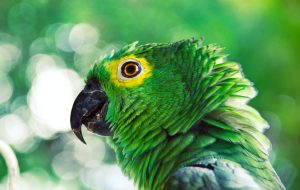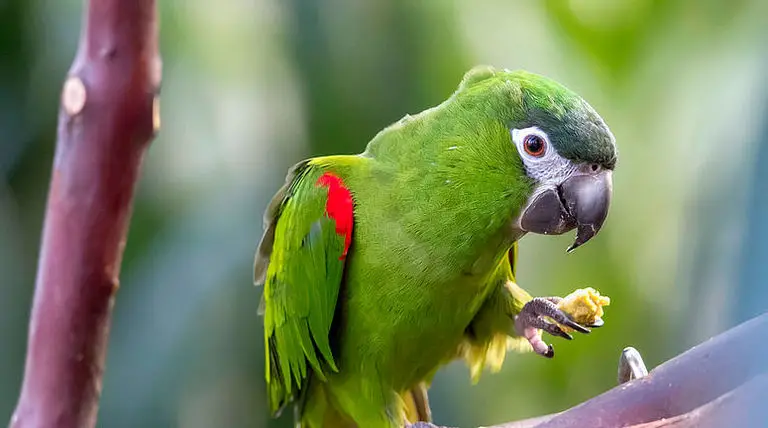There are big birds that only extreme pet collectors try to take on, and then there are the smaller ones who have just as big a heart and really do make up for their physically small stature.
The Hahn’s Macaw, a miniature version of the colorful parrot, is very much in this category.
The creature is lovable, social, noisy if trained to be so, active, perks up to interact, and best of all can be managed very easy due to its small stature (which is a good thing for pet owners who don’t have a whole lot of space to work with).
The Hahn’s Macaw is technically a mini-macaw. It looks very much like its other macaw cousins, albeit without the big feathers on the tail or crest crown on other birds.
However, the Hahn’s Macaw does come in a typical deep lime green color, and these critters more than make up for their size with how attached they get to their owners for interaction.
Naturally, the Hahn’s Macaw is found in South America, in large populations on both the Atlantic and Pacific sides. Geographically, the birds will be most often located in the flatlands in either jungle or savannah.
Learn About Hahns Macaw Lifespan
As a pet, the Hahn’s Macaw does need a varied diet to live well. This is a key factor in literally how long the bird will live. Typically, hahns macaw lifespan average is 30 years but some vibrant examples have gone a half-century.
Taken care of well, owners do need to consider the longevity of these birds and how to take care of them if the owner him or herself should need to transfer the bird late in life to someone else.
This is probably not the bird pet to think about getting if one is already in retirement, for example.
Hahns Macaw Personality
An additional factor affecting the constitution of the bird is how much space and exercise the Hahn’s Macaw receives or can access.
Sitting around and these animals act very much like humans in the sense that they get fat and unhealthy from overeating and no-calorie burning.
They are also big on entertainment, which means a typical owner will need to plan for lots of time spent with the bird, even if just playing with it lightly.
Hahn’s Macaws want attention, period. Many a bird has grown depressed and unhealthy, even engaging in self-mutilation out of boredom and lack of interaction.
Like most parrots, the Hahn’s Macaw will learn to vocalize and respond in kind if taught to do so.
They are very intelligent and inquisitive, two traits that help them figure things out, including how to get out of their containers if left unlocked.
That said, they want to belong, so once bonded to a pet owner they are more than likely to figure out a way to get close and be held.
They, however, do love to chew on things and climb, so fabric materials are going to get torn up with regular tracking.
Considering Interaction With Kids
If the bird is going to be a pet for a child, the Hahn’s Macaw will be a far better choice than a full-size bird. One, they can be handled far easier.
Two, they are not aggressive per se and like to be handled. They also don’t nip very much as long as they are cared for gently.
Obviously, young children having such a bird is out of the question, but pre-teens and young teens will definitely love these mini-macaws for pets (except maybe at night if the bird refuses to be quiet but that depends on how it has been trained).
Hahns Macaw Food & Care

Size-wise, a normal Hahn’s Macaw will grow something between 12 to 14 inches in full length.
Again, this is a good size for a compact space, such as an urban living in a condo or apartment, but these birds can be noisy.
Depending on how they are exposed to stimuli, these mini-macaws can whistle, squawk, squeak, and croon for attention.
In terms of physical health, the Hahn’s Macaw can be afflicted by all the same issues as any other macaw bird, and they have a typical issue with ongoing beak growth.
So, they need the proper tools to keep the beak sized and wearing down regularly (i.e. grinding).
Again, diet is a big part of their overall health and vibrancy. A proper mix of lots of different nuts, fruit, plant-based food, and chewing is a must.
High protein nuts are a big plus and pre-designed nut bars are often given a good mix of a macaw’s diet in captivity. But don’t be surprised if the little fellow start’s trying to pilfer snacks when let loose to wander.
The Average Hahns Macaw Price
HaHns Macaws price falls between $650 to $1400 from a licensed breeder or commercial store depending on size and age.
Because they tend to be so popular and easy to manage, Hahn’s Macaws are fairly easy to find.
They won’t be the lowest cost bird due to being a parrot, but they are stocked in good numbers nationwide at bird-specialty vendors.
Ideally, you want to secure your new pet from a licensed breeder or commercial store.
These birds have been known to be smuggled in some markets, and consumers who try these avenues to save a few dollars are often saddled with a traumatized bird suffering multiple health issues for years. It’s simply not worth the trouble.
If you’re looking for a parrot or similar bird pet, but you don’t want a big production and large cage, then the Hahn’s Macaw is probably one of the best bets for a starting bird pet.
But again, remember, their long life span means you’re making a long-term commitment to care for this kind of bird. So be willing to commit to a life partner.
Hahn’s Macaw History/Origin
The red-shouldered Macaws exist in two different types. The Hahn’s Macaw is one, while the Noble Macaw completes the list.
Both birds are known to have originated from Northern South America. The name is in honor/appreciation of the famous/highly experienced zoologist “Carl-Wilhelm Hahn” of German origin.
Like other true Macaw species, the Hahn’s Macaw lives in the wild (their natural habitat) and are commonly found in three countries (Venezuela, Brazil, and Guyana) across the swamplands, tropical lowlands, and Savannas.
While in the wild, they are known to move in groups, not really big flocks.
The Hahn’s Macaws are so beautiful to watch in their natural habitat. Their beautiful feathers (green) combine/complement the plants and vegetation in these environments impressively for an appealing view.
Compared to other small Macaws, Hahn species have the smallest body size. Also, they are the most popular miniature/small Macaw.
The popularity may be attributed to their compact size, making them a perfect fit for individuals who do not have a big/expansive area in their homes to breed a large Macaw.
Hahn’s Macaws Features
- Beautiful/attractive feathers (green)
- An adult Hahn’s Macaw has an average size of about 12-inch
- They are fun/playful birds, making it easy to form strong companionship/bonds with individuals who own and take care of them
- Hahn’s are intelligent birds. They are not restricted to naturally acquired behaviors/tricks. As a result, they can easily pick up a new way of life.
- Improved speech capabilities with adequate training and practice.
- On average, this bird can live for up to 20 years. There are records of Hahn’s who live up to 30 years.
- Suitable/perfect birds for individuals with limited space or families.
How to Pet Hahn’s Macaw
There is no way any bird lover won’t fall in love with this beautiful and charming parrot.
One of the misconceptions anyone could have is believing their small/compact size makes them an easy Macaw to handle/train/care for.
Don’t be deceived by their little appearance/size. Think about all the behaviors/attributes associated or popular with the larger Macaw species. The Hahn’s Macaw also possesses all of these personalities.
Like every other Macaw, this species also requires a lot of attention. The owner has to dedicate a few hours daily to watch, play, train, and bond with them.
Naturally, Hahn’s are energetic and playful. Leaving them in their cage without the freedom to interact with you or move around the house could lead to boredom, negatively impacting their health.
If you live with other people, especially individuals that are not lovers or excited about birds in general.
Considering its noisy nature, it could be difficult to pet a Hahn’s Macaw in such a condition. When they choose to be noisy/loud, they go all out for it.
Common Ask Questions
What makes the Hahn’s Macaw an excellent talker?
Earlier, we highlighted/discussed the high level of intelligence this bird possesses, which further enhances their speech capabilities.
When you dedicate adequate time to train and bond with them daily, they can easily be taught new words/phrases, which they learn and understand in a matter of time.
How do you care for the Hahn’s Macaw?
Irrespective of the species, all Macaws seek the same level of attention and care.
So, the requirements (food, exercise/training, and social) that apply to the larger species are associated with the small to mid-size species.
Ensure the food the Hahn’s Macaw eats is healthy and highly nutritious.
Foods like parrot mix (top-quality), vegetables, nuts, flower buds, stems, berries and seeds should not be absent from their diet.
Also, not creating enough time for this bird could result in unattractive behaviors.
Whenever Hahn’s Macaw feels isolated/neglected, it triggers some emotions. At that point in time, anger, depression, and destructive behavior kick in.
Is Hahn’s Macaw expensive to own/care for?
Macaws are high-maintenance pets. There have been situations where people pick up a Macaw today only to put them up for adoption after sometimes as the financial commitment that comes with owning one begins to unfold.
The cost of purchasing a new and solid cage, the price of quality foods, and how much it costs for each vet visit are not low/cheap.
Before anyone decides to pick up a Hahn’s Macaw as a pet, such an individual must be financially stable/buoyant to cater for this precious bird.
Being fascinated about these birds (Macaws generally) isn’t enough. You need to be sure that all they need to live their best life can be provided at the right time.
What cage size should I get for my Hahn’s Macaw?
As stated earlier, this bird is compact in size and does not require an expansive cage. Nevertheless, it is not an excuse to just settle for any type/size of cage.
The idea isn’t about investing in one that can easily fit the bird’s size when choosing a cage. You need to consider if it has extra space to allow free movement and support the integration of accessories that the bird needs to live a healthy and happy lifestyle.
Choose a cage that doesn’t hinder the stretching/expansion of feathers. The bird must be able to expand its wings ultimately without the cage coming in its way.
A cage with a dimension of 3.0H x 3.0L x3.0W is an ideal pick.
How do I train my Hahn for best behavior?
Don’t forget how intelligent this bird is, especially how easily/quickly they pick up new activities.
Whatever behaviors you do not want them to possess or exhibit, keep such actions away from them. Instead of being aggressive with corrections, choose positive reinforcement instead.
By settling for an aggressive scolding mechanism, the bird sees such an approach as standard/acceptable, exhibiting such character in the process.
Whenever they do something right/appropriate, do not allow such a moment to go unrewarded. This is a simple yet effective way to ensure they understand the acceptable or not behaviors.
Final Say
Individuals who desire to adopt/buy the Hahn’s Macaw at the early stage of development (when they are still young). It is essential to have complete knowledge of what lies ahead and prepare for it.
A young Hahn’s Macaw has a high tendency to nip. It isn’t a big issue since they become friendlier/calm as they grow older or mature.
With enough time for handling, interaction, and socialization, this Macaw species are arguably one of the sweetest bird pet anyone would love to own.

Hi, I’m Regina Rios. Just another bird lover who loves to share knowledge from personal experience. I’ve grown up with pet birds since childhood as my mommy also loves birds. As I can’t pet many birds in open air in my house as my mom does; I created my first bird cage on my rooftop using wood, copper wire, and a metal shed in 2018 and start collecting pet birds. Now, I have so many pet birds such as Macaws, Parrot, Cockatiel, Parakeet, and others. Not only that, if I see natural birds are injured I keep them in my house until they get well. Now, my hobby becomes my income source as my home birds have babies and I sell them to birds lover like mine. I’ve created this blog to inspire others bird owners by sharing my personal knowledge. Good Luck!

